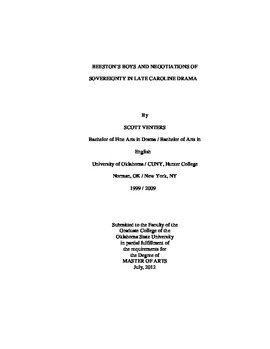| dc.description.abstract | Recent revisionist histories and scholarly analyses have opened up spaces for local critiques of social drama and the drama in the social life of late Caroline England. This essay examines the political and cultural relevance of one particular acting troupe, The King and Queen's Young Company, popularly known as Beeston's Boys. Prior scholarship has tended to discount Beeston's Boys as either a "failure" in achieving legitimate boy company status (since it was a company of older boys and young adults), a status which hearkens back to Elizabethan and early Jacobean dramatic tastes, or as a negligible anomaly arising from the crisis of plague closures in 1636-1637. Beeston's Boys, ascending as it did during this moment of cultural `decline,' warrants more attention for its aberrant formation, unorthodox protocol, and ambivalent attitude toward kingship and the body politic. This essay argues that Charles certainly used the company to endorse images of religio-political order resonant with Elizabethan England and to adumbrate conjugal harmony and positive portrayals of Queen Henrietta Maria, but MPs, Peers, courtiers, gentry, and artists were also communicating social anxieties and concerns through a predilection for problematic tropes of inversion, disorder, abuses of power, and an increased emphasis on the civic-body of London over and above notions of monarchy. During the early years under Christopher Beeston's management, the company relied on the poetics of Henry Glapthorne to draw closer to the court and the courtier style of drama. However, after Christopher's death, his son William found it politically expedient to alienate the court and reach out to Charles's antagonists, primarily through the work of popular dramatist Richard Brome. In essence, the biography of the company mirrored the factionalized biography of England just prior to the Civil Wars. The methodology employed in this examination of Beeston's Boys is similar to that utilized by Lucy Munro in Children of the Queen's Revels with its concentration on repertory and genre, but more attention is placed on the particular representational strains of bodies of sovereignty (i.e. the King and Queen and the body politic including its extremities or fringe identities), modes of inversion (specifically sexual), and the dialogic participation of Beeston's Boys in `Elizabethanism.' The final textual product reveals The King and Queen's Young Company embedded in a tableau of overlapping and turbulent discursive circles. | |
